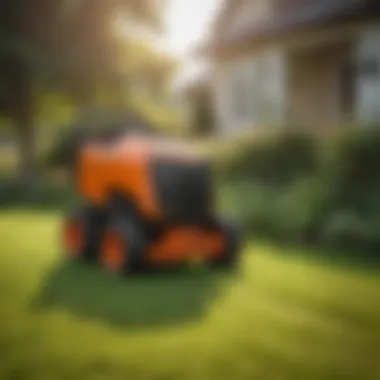Exploring Mini Balers for Lawn Mowers: Benefits & Uses


Intro
The mini baler represents a significant innovation in the realm of lawn care and agricultural management. It serves as a compact solution for those who aim to maintain tidy landscapes while maximizing the benefits of their efforts. Gardeners, whether hobbyists or professional landscapers, can harness the capabilities of mini balers to streamline their operations.
In today’s competitive gardening environment, efficiency and resource optimization play critical roles. As the interest in sustainable practices continues to grow, understanding how mini balers function can equip individuals with valuable insights into creating effective urban and rural spaces. This piece aims to deliver a thorough examination of mini balers, detailing their applications and advantages, backed by current research and data analysis.
Prolusion to Mini Balers
As we delve into the subject of mini balers, it is essential to understand their significance in modern gardening and landscaping. Mini balers act as crucial tools for optimizing yard maintenance and addressing the challenges posed by grass and vegetation management. By harnessing the technology behind these machines, users can expect not only improvements in their landscaping tasks but also a greener approach to waste management.
Definition and Overview
A mini baler is a compact machine specifically designed to compress and bundle materials such as grass clippings, leaves, and small plant cuttings into manageable bales. Unlike traditional balers, which are typically larger and more suited for agricultural use, mini balers offer unique advantages for residential and small-scale commercial settings. Their size makes them suitable for smaller lawns or gardens and allows for easier maneuverability in tighter spaces.
These machines generally feature a simple mechanism for collecting, compressing, and tying the material, making them accessible for users who might not have extensive experience with agricultural machinery. The various models available on the market cater to different needs, promoting efficiency in yard upkeep while minimizing environmental impact.
Historical Context
The evolution of mini balers can be traced back to advancements in agricultural machinery during the 20th century. Traditionally, balers were massive machines utilized primarily in farming to handle large quantities of hay or straw. With an increasing emphasis on efficient yard maintenance and sustainable practices, the need for smaller, more adaptable equipment arose.
The introduction of mini balers came as a solution to this demand. Initially, these machines were rudimentary, but technological advancements led to significant improvements in their design and functionality. Over the years, manufacturers have addressed specific user requirements, including portability, ease of use, and energy efficiency. Therefore, it can be said that the development of mini balers reflects both a response to shifting consumer needs and ongoing innovation in the equipment sector.
Design and Functionality
Understanding the design and functionality of mini balers is crucial for interpretting their applications and benefits. These machines are tailored for efficient grass and debris collection during lawn and garden maintenance. Their compact size is one of their defining features, making them suitable for both residential and commercial use. This section will focus on the key components and mechanisms that facilitate the operation of mini balers, underscoring their importance in enhancing productivity in landscaping efforts.
Key Components of Mini Balers
Mini balers consist of several essential components that play a significant role in their operation:
- Chamber: The chamber is the main area where the cut materials accumulate before being compacted into bales. The design of the chamber influences the density and size of the bales produced.
- Feeder System: This system takes in the grass or debris from the mower. A well-designed feeder ensures a steady flow of material into the chamber, minimizing jamming or blockage.
- Compaction Mechanism: This mechanism compresses the material into a tight bundle. Different balers employ various methods for compaction, impacting the overall efficiency of the baling process.
- Bale Ejection System: After compaction, the ejection system releases the bales for easy handling. Quick and efficient ejection is vital for maintaining workflow in landscaping tasks.
- Frame and Wheels: The sturdy frame provides stability during operation, while the wheels facilitate easy movement across various terrains.
These components work synergistically to create a machine that is both efficient and user-friendly.
Mechanisms of Operation
The operation of mini balers is characterized by a systematic approach that maximizes efficiency. Here’s how they function:
- Initialization: As the mini baler is towed behind a lawn mower, it begins the operation by engaging the feeder system.
- Material Intake: Grass and debris are drawn into the feeder. Sensors may be employed to regulate the intake based on material density.
- Compaction: Once inside the chamber, the materials are compacted. This involves a series of mechanical actions where blades or paddles compress the grass.
- Bale Formation: The compressed material is then tied together, usually with twine or wire, forming a stable bale.
- Ejection: Finally, the bale is ejected from the back of the unit, ready for storage or transport.
"The combination of design and operational mechanisms defines the overall effectiveness of mini balers, making them indispensable for efficient lawn care."
These steps highlight the importance of each component and how they impact the functionality, ultimately helping users achieve their landscaping goals effectively.
Benefits of Using Mini Balers with Lawn Mowers
Mini balers have transformed the way lawn maintenance is approached, providing a multitude of benefits for both amateurs and professionals in gardening and landscaping. By integrating mini balers with lawn mowers, users can achieve significant enhancements in efficiency, waste reduction, and composting possibilities. This section delves into these primary advantages, illustrating why mini balers should be considered indispensable for optimal yard maintenance.
Efficiency in Yard Maintenance
Efficiency is paramount in yard maintenance, especially for those managing large spaces or commercial properties. Utilizing a mini baler in conjunction with a lawn mower streamlines the process of collecting and compacting grass clippings and other yard debris.


- Reduced Time and Labor: With the ability to easily collect cut grass, garden waste, and other materials without the need for manual gathering, operators can save considerable time. The task of yard work becomes less labor-intensive, freeing up hours that can be redirected towards other gardening efforts.
- Simplified Cleanup: The design of the mini baler allows for efficient handling of green waste. A single pass with a mower equipped with a baler can effectively manage debris, making the overall yard cleanup much more straightforward. This capability ensures a consistently tidy lawn without excessive effort.
Reduction of Waste
Another critical benefit of using mini balers is the significant reduction of waste. Traditional yard maintenance often leads to large amounts of organic debris being sent to landfills. In contrast, mini balers allow for better waste management practices through compaction and collection.
- Less Volume: By compacting the collected grass and organic material, mini balers decrease the volume of waste produced. This means less frequent trips to waste disposal locations, which is both time-saving and economical.
- Environmental Responsibility: Reducing waste also directly impacts ecological footprints. When fewer materials are disposed of in landfills, it helps alleviate the strain on waste management systems. Furthermore, many users opt to compost the baled materials, returning nutrients to the soil rather than contributing to landfill mass.
Enhanced Composting Options
The integration of mini balers complements composting efforts, enriching the capacity to create nutrient-dense soil amendments. The baling process allows for controlled management of gathered materials, making composting a more viable practice.
- Quality Compost Material: The grass cuttings collected by the mini baler consist of high-nitrogen content, which is essential for effective composting. When properly managed, these clippings can turn into rich compost that enhances soil fertility.
- Easier Transport: The compacted nature of baled materials facilitates easier transportation to composting sites. This aspect is particularly beneficial for gardeners who frequently move organic waste but do not have the means to transport large quantities of loose material.
Engaging with mini balers effectively changes the landscape of lawn maintenance, offering crucial advantages in efficiency, waste reduction, and sustainable practices.
In summary, the benefits of using mini balers alongside lawn mowers cannot be overstated. The enhancements in efficiency, the commitment to waste reduction, and the improvement in composting practices all contribute to a more sustainable approach to landscaping. As these machines become more accessible, their adoption can be a key factor in the future of yard maintenance.
Application Scenarios
The application scenarios for mini balers are important to explore because they showcase the versatility and practicality of these tools in various contexts. Understanding how and where mini balers can be efficiently utilized helps users select the right equipment for their needs. This section delves into specific areas where mini balers excel, providing insight into the unique benefits each application offers.
Home Gardening
In the realm of home gardening, mini balers prove to be invaluable for anyone managing a small to medium-sized garden. They offer great efficiency in collecting and compressing grass clippings, leaves, and other organic debris. This enables gardeners to maintain a neater yard, free from clutter, whilst making waste more manageable.
One advantage is their size and ease of use. Unlike larger balers, mini balers can easily fit in smaller spaces, making them ideal for homeowners who may not have access to extensive equipment storage. Utilizing a mini baler can also reduce the frequency of trips to disposal sites, saving time and effort.
In addition, mini balers open doors to enhanced composting practices. Gardeners can create compact bales of organic waste that break down more quickly when added to compost heaps. This promotes healthier soil and supports sustainable practices.
Professional Landscaping
For professional landscapers, the use of mini balers presents numerous benefits aligned with business goals. Efficiency becomes a priority when managing projects for multiple clients, and mini balers are designed to save both time and labor costs. By collecting debris efficiently, landscapers can swiftly move on to the next job, maximizing productivity.
These balers also enhance presentation. By creating tidy bales from organic waste, landscaping professionals can deliver a more polished look to their projects. It reflects well on their business and attracts potential clients.
Moreover, it supports eco-friendly practices. Clients often prefer environmentally sustainable landscaping solutions, and demonstrating the use of mini balers can significantly bolster a landscape professional’s green credentials. Earning a reputation for such practices can lead to increased business opportunities.
Agricultural Settings
In agricultural settings, mini balers cater to small-scale farmers and hobbyists. They provide a practical solution for managing crop residues and excess hay effectively. For instance, after harvesting, farmers often need to deal with leftover plant material. Mini balers allow efficient compaction and storage of this debris, conserving space and facilitating easier handling.
The reduced size of mini balers means they can operate in tighter fields or smaller operations, where larger counterparts may be impractical. Farmers can benefit from the ability to create dense bales that are easier to transport and manage.
Costs are also more manageable. Smaller balers typically come at a lower price point and require less power. This accessibility encourages more farmers to embrace efficient waste management practices, contributing to overall sustainable agriculture.
Understanding the application scenarios of mini balers reveals their potential in promoting efficiency and sustainability across various sectors.
Comparative Analysis
In the context of mini balers, a comparative analysis is vital for understanding their place in today's agricultural and landscaping practices. This section will delve into the distinctions between mini balers and traditional balers, along with critical cost efficiency considerations. By examining these two aspects closely, users can make well-informed choices tailored to their specific needs and contexts.
Mini Balers vs. Traditional Balers


When comparing mini balers to traditional balers, various factors need to be taken into account. Mini balers are designed for small-scale operations, providing several advantages in specific scenarios.
- Size and Portability: Mini balers are more compact, making them easier to transport and maneuver. This aspect is crucial for home gardeners and small landscaping projects.
- Operational Efficiency: Mini balers can quickly handle grass clippings, small bales of straw, or other organic waste, improving yard maintenance efficiency compared to larger machines that may require more setup and handling time.
- Cost of Ownership: The initial investment in a mini baler is typically lower than that of a large traditional baler. Additionally, the maintenance costs associated with mini balers are often reduced due to fewer moving parts.
Despite these advantages, traditional balers are not without their merits. They might be more effective for larger operations and can handle bigger volumes and types of materials. Thus, the choice between the two often hinges on the user's specific operations and needs.
Cost Efficiency Considerations
Cost efficiency is a key element in deciding which baler system to adopt. Here are a few points to consider regarding mini balers' cost efficiency:
- Purchase Cost: Mini balers generally have a lower purchase price compared to most traditional models. This initial saving allows budget-conscious gardeners and landscapers to equip themselves adequately without extensive financial burden.
- Fuel Efficiency: Mini balers consume less fuel than traditional balers. This can lead to significant savings over time, especially for those who do regular lawn maintenance.
- Time Savings: By quickly processing smaller quantities of material, mini balers reduce overall labor costs. Users can complete tasks faster, allowing them to focus on other important activities.
"Investing in a mini baler could lead to effective savings while maintaining quality in yard care, especially for hobbyist gardeners."
Ultimately, while both mini and traditional balers have their respective strengths, it is essential to weigh these factors to find a suitable balance between efficiency, cost, and the specific application at hand.
Environmental Impact
Understanding the environmental impact of mini balers is essential as they redefine waste management in gardening and landscaping contexts. This section explores how mini balers contribute to sustainability and help preserve natural resources.
Sustainable Practices
Mini balers play a pivotal role in promoting sustainable practices within gardens and landscaping activities. By enabling effective waste collection, they assist in converting grass clippings and other organic debris into manageable round bales. These bales can then be repurposed, reducing landfill waste and encouraging recycling of organic material.
For gardeners and landscapers, adopting mini balers means embracing environmentally friendly methods. Some of the major benefits include:
- Waste Reduction: Mini balers compact yard waste, making it easier to store and transport rather than letting it decompose on site.
- Resource Conservation: By recycling organic materials, these devices contribute to resource conservation by keeping usable nutrients in the ecosystem.
- Lower Carbon Footprint: Efficient use of mini balers leads to reduced frequency of waste collection trips, thereby decreasing fuel consumption and minimizing carbon emissions.
Incorporating mini balers represents a significant shift towards more eco-conscious gardening, where waste can become a valuable resource rather than a burden.
Soil Health Enhancement
The use of mini balers not only addresses waste management but also fosters enhancements in soil health. The organic material that is baled can significantly benefit the soil quality once it is returned to the garden or used as mulch. This process enriches the soil in various ways:
- Nutrient-Rich Material: When organic waste, like grass clippings, is utilized as mulch, it decomposes to release essential nutrients back into the soil.
- Soil Structure Improvement: Shredded organic materials improve soil structure, aiding in water retention and promoting healthy root growth.
- Microbial Activity Stimulation: Organic matter enhances microbial activity in the soil, crucial for a balanced ecosystem.
"Investing in practices that improve soil health is investing in the future productivity of agricultural land."
By integrating mini balers into their routine, landscapers and farmers can sustain healthy soil ecosystems. Not only does this enhance plant growth, but it also contributes to a more balanced environment overall.
In summary, the environmental impact of mini balers extends well beyond mere operational efficiency. They foster sustainable practices and facilitate soil health improvements, ultimately leading to a more harmonious relationship between landscape maintenance and environmental stewardship.
Maintenance and Care
Proper maintenance and care of mini balers is vital to ensure they operate efficiently and last longer. Just like any mechanical equipment, neglecting this aspect can lead to malfunctions, reduced performance, and ultimately increased costs for repairs or replacements. It’s important to establish a routine that includes regular checks and servicing. This can help practitioners uncover potential issues before they escalate, which can be a saving grace during peak working seasons.
Routine Maintenance Guidelines
Routine maintenance involves several steps that users should incorporate into their regular schedules. Here are some key tasks:
- Inspect Moving Parts: Regularly check all moving components for wear and tear. Parts such as belts, chains, and gears are particularly susceptible to damage.
- Clean After Use: Debris from grass clippings, dirt, and other materials can accumulate and hinder performance. After each session, clean the baler thoroughly to prevent clogs and ensure smooth operation.
- Lubrication: Apply appropriate lubricants to any moving parts as per the manufacturer's guidelines. This reduces friction and helps prevent unnecessary wear.
- Check Bolt Tightness: Ensure that all bolts and fasteners are tight before starting work. Loose components can lead to additional strain on the baler and potentially result in damage.
Adhering to these guidelines can greatly enhance the efficiency and longevity of the mini baler.


Troubleshooting Common Issues
Despite regular maintenance, some issues can still arise. Here are common problems faced by users and ways to troubleshoot them:
- Baler Not Picking Up Material: If the baler struggles to gather material, first check if the height is set adequately. Adjust the height accordingly. If that doesn’t resolve the issue, inspect the pickup mechanism for blockages.
- Jamming Issues: Frequent jams can indicate either an overload of material or a mechanical issue with the baler. Reduce the amount of material being fed and check for any damaged parts within the mechanism.
- Uneven Bales: If bales are forming unevenly, the problem might lie in the tension settings. Review the tension levels and make adjustments to ensure consistent packing.
- Hydraulic Problems: For models equipped with hydraulics, check fluid levels regularly. Low hydraulic fluid can lead to operational issues. If problems persist, it’s wise to consult the service manual or a professional technician.
Maintaining the mini baler is a key part of ensuring that it works effectively and lasts longer. Regular checks can prevent larger issues down the line.
Addressing these common issues swiftly will keep the mini baler functioning at its best, facilitating efficient lawn maintenance operations.
Future Trends in Mini Baling Technology
The advancements in mini baling technology hold significant implications for agriculture and landscaping. As environmental concerns rise, the demand for more efficient tools becomes essential. One of the main objectives is to optimize resource usage while minimizing waste. Future trends in this sector reflect the need for enhanced functionality, adaptability, and efficiency in operations.
Automation and Smart Technology
Automation is reshaping many industries, and mini baling technology is no exception. The integration of smart technology into mini balers enhances their capabilities, streamlining processes and increasing productivity. Features such as automatic adjustments for varying conditions ensure that baling is efficient regardless of the landscape.
For example, sensors can monitor real-time performance, providing feedback on the quality of bales produced. This enables users to make informed adjustments on-the-fly, reducing the time spent on manual checks. Additionally, smart technology can allow for remote monitoring. This means that operators can oversee operations from a distance, further enhancing productivity.
The implications of these technological advancements are not only operational but also financial. A more automated baler can reduce labor costs and improve the return on investment, allowing both hobbyists and professionals to allocate resources more efficiently.
Potential Innovations
Potential innovations within this field are vast and promise to further transform mini balers. Researchers are currently exploring several possibilities. One area of focus is the development of biodegradable materials for baling. This could significantly reduce the environmental footprint of baling operations.
Moreover, advancements in battery technology could lead to more efficient electric mini balers. These electric options generate less noise and pollution, making them particularly appealing in urban and suburban settings. The reduction in fuel consumption and emissions aligns with broader sustainability goals.
Another innovative idea under consideration involves modular designs. These would allow users to customize and adapt balers according to specific tasks. For instance, a modular design could let users swap out components for different types of vegetation, enhancing versatility. This could cater to diverse gardening and landscaping needs, making mini balers even more accessible for varied applications.
"As we move towards a more sustainable future, the role of technology in agriculture becomes increasingly vital. Mini balers with enhanced automation and innovative designs can meet modern expectations."
Culmination
The conclusion serves as the capstone of the discussion on mini balers for lawn mowers. Summarizing the intricate details covered, it highlights the importance of understanding both the potential and limitations of mini balers in various applications. Recognizing their role in enhancing yard maintenance practices reflects a broader awareness of contemporary landscape management.
Several key elements emerge throughout the narrative:
- Efficiency: The integration of mini balers with lawn mowers streamlines the grass-cutting process. This efficiency not only saves time but also maximizes output.
- Waste Reduction: Mini balers contribute significantly to reducing physical waste. The compacting of materials promotes resource conservation.
- Sustainable Practices: A focus on environmental benefits such as composting options directly ties into sustainable gardening practices. Mini balers encourage landowners to think more critically about waste utilization.
These elements underscore the need for awareness among users. Understanding how to implement mini balers effectively can lead to improved results in both home gardening and professional landscaping.
Summary of Key Points
In summary, the mini baler’s functionality offers substantial advantages:
- They are designed for different scales of operation, from home gardens to larger professional landscapes.
- The compact bales contribute to easy transport and disposal, enhancing overall yard management.
- Mini balers are usually cost-effective solutions compared to traditional balers, especially for smaller projects.
- They also play a key role in environmental sustainability by promoting effective composting methods.
These key points reiterate the efficiencies gained through the use of mini balers, emphasizing their relevance in today’s gardening context.
Final Thoughts on the Role of Mini Balers
The role of mini balers transcends mere agricultural tool use. These machines symbolize a shift toward more sustainable landscaping practices. Their impact resonates particularly with hobbyist gardeners and professional landscapers eager to optimize their operations. As society becomes increasingly aware of environmental issues, devices like mini balers can foster a more sustainable approach to yard maintenance.
Their continued evolution with tech advancements underscores the importance of adapting to new tools for enhancing productivity and ecological consciousness. By embracing mini balers, users not only improve their immediate surroundings but also contribute to broader environmental goals.
"In today's world, every choice in gardening echoes a commitment to sustainable practice. Mini balers present a tangible way to marry efficiency with environmental responsibility."
Their significance is undeniable, marking them as essential to both functionality and sustainability in modern landscape management.















